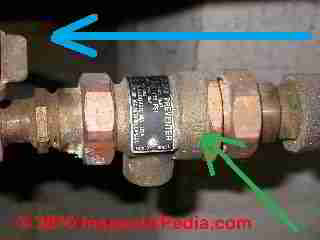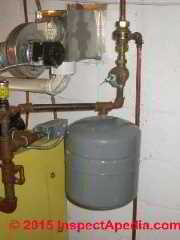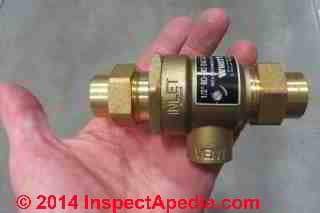 Backflow Preventer Valves for Heating Boilers
Backflow Preventer Valves for Heating Boilers
BBFP requirements, functions, installation, leaks, troubleshooting
- POST a QUESTION or COMMENT about hydronic or steam boiler back flow preventer valves
Heating boiler backflow preventer valves (BBFP): this article describes check valves installed on the water supply to heating boilers to prevent heating system water from re-entering the building potable water supply system and its piping.
Backflow preventers are installed on hot water (hydronic) or steam boilers on the boiler water feed line as required by both good plumbing practice and by building codes in many jurisdictions.
This article describes backflow preventers used on heating boilers including their function, location or placement, and their troubleshooting and repair of leaks or other problems.
InspectAPedia tolerates no conflicts of interest. We have no relationship with advertisers, products, or services discussed at this website.
- Daniel Friedman, Publisher/Editor/Author - See WHO ARE WE?
Heating Boiler Backflow Preventer Valves [BBPF] on Heating System Piping - A Different Check Valve
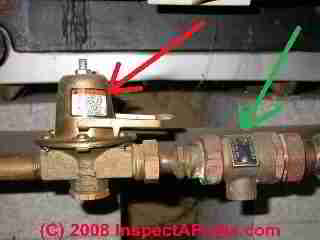 Heating system backflow preventer valves protect public water mains as well as private building water piping from heating system water contaminants.
Heating system backflow preventer valves protect public water mains as well as private building water piping from heating system water contaminants.
At a hot water heating system a heating system backflow preventer check valve is used to keep hot, high pressure water in the hydronic heating system from flowing backwards through a boiler water feed line into the building water supply - a sanitation concern.
[Click to enlarge any image]
Why do we need a Backflow Prevention Device on Heating Boilers?
Because a building potable water supply piping cold water line is used to deliver water to hydronic or steam heating boilers, we need to prevent heating system water from back-contaminating the building water supply piping.
This back-contamination, or back-flow could occur, for example, if there were a loss of water pressure on the building supply-side of the heating boiler. In that condition, the boiler water, typically at 12-30 psi depending on boiler temperature, could be forced back into the building's potable water piping system, contaminating it with boiler chemicals or debris, even bacteria.
At our hot water heating boiler backflow preventer photo (above left) the automatic water feed valve (red arrow) includes a built-in backflow prevention device, while a separate, code-required backflow preventer valve is shown by the green arrow.
Our photo at below shows a similar backflow preventer valve (green arrow) installed at a steam heating boiler. Again you'll see that the valve is installed between the potable water supply piping and all other boiler controls and components.
Click to see a CLOSE-UP PHOTO of this backflow preventer on a steam boiler.
More generally connection of potable water piping to any device that could potentially send unsanitary water backwards into the potable water system is called a cross connection - a potential drinking water sanitation issue explained in detail
at CROSS CONNECTIONS, PLUMBING.
So we install a backflow preventer - a special check valve - at the heating boiler.
Separately from the backflow preventer valve shown in the photos above, at both hot water (hydronic) heating boilers and steam heating systems a backflow preventer may also have been built into the automatic water feed valve itself - a separate control described in our article on WATER FEEDER VALVE, HYDRONIC BOILER in that article's section
at BACKFLOW PREVENTER, HEATER WATER FEEDER.
Depending on local plumbing codes, a separate (from the water feeder valve) dedicated backflow preventer valve may also be installed "upstream" of the automatic water feeder - that is, between the heating system water feed valve and the incoming municipal water supply cold water piping (green arrow).
A close up of the separate heating backflow preventer is shown in a second photograph at left.
These are two separate devices for heating system water backflow prevention, but often you will see both of them installed.
The blue arrow in our photograph shows the direction of water flow into the water feeder and onwards into the heating boiler.
In sum, backflow preventers found on heating systems are installed to prevent higher-pressure heating system water from being forced backwards (say through a water feeder valve) into the building potable water supply piping.
Details about automatic water feeders used on heating boilers or steam boilers are
at WATER FEEDER Valves, Hydronic
and WATER FEEDER VALVE, STEAM.
Backflow Preventer Valve Installation Position on Heating Systems
The backflow preventer valve such as the Watts 9D Dual Check valve can be installed either horizontally or vertically on the building water supply piping, but it should be positioned at the heating boiler before (on the supply side) the pressure regulator and as you will note in our photos below, it is also ahead of the expansion tank.
[Click to enlarge any image.]
Shown above and below: a Conbraco™ Series 40-400 continuous pressure backflow preventer installed at a residential heating boiler. The company's catalog describes this product as follows:
The Conbraco Series 40-400 Continuous Pressure Backflow Preventer is designed to protect residential and commercial water supply lines from back-siphonage or back-pressure of non-potable (non-hazardous) substances. It has an intermediate atmospheric vent to insure protection from backflow conditions
. It consists of two independently acting and spring-loaded check valves in a corrosion resistant material.
During normal flow operation, the vent valve is closed, and the two check valves are open allowing flow of water through the unit.
Each check valve is designed to hold at least 1 psi in the direction of flow.
When a back-siphonage condition occurs, both check valves close and the atmospheric vent opens to permit air to enter the intermediate zone.
In the event of back-pressure and if the second check valve is prevented from closing tightly, leakage will be vented to the atmosphere through the vent port. - Conbraco™ cited below.
Reader Question: in what order should the backflow preventer be installed?
(Mar 17, 2013) DW said: I am in New York city where a check valve or back flow preventer (3/4 BBFP) [Boiler Back Flow Preventer] is required for domestic heating systems. I have a indirect hot water tank attached to a gas boiler.
My question is - What order should the back flow preventer be installed in A or B. We have had no problems but neighbors with the same set up have had a lot of leaks from the check valve
A. city water>BBFP>expansion tank>hot water tank
or
B. city water>expansion tank>BBFP>hot water tank
Note: BBFP Dual Check Valves with Intermediate Atmospheric Vent prevent the reverse flow of hot or cold polluted water from entering into the potable water supply. It consists of a brass body with stainless steel internal parts, integral strainer, and two durable, tight-sealing, rubber check valves.
Designed for continuous pressure, non-health hazard applications in smaller supply lines, such as laboratory equipment, processing tanks, sterilizers, dairy equipment, and specifically for boiler feed lines. Minimum Working Pressure: 25psi (172kPa), Maximum Working Pressure: 175psi (12.06 bar)
Reply:
Above at DW's question we include photographs of Conbraco™ backflow preventer check valve installed at a residential heating boiler.
You'll see that the back-flow preventer is installed on the building potable water supply piping ahead of the pressure reducer/regulator valve and ahead of the expansion tank. This is the proper location.
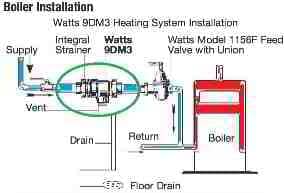
Thanks for the question DW, above I have included an adapted schematic provided by Watts corporation showing the installation position of the 9D Dual Check Valve with an atmospheric vent (above left) .
The BBFP you cite probably refers to Watts BBFP, 3/4" CxC Backflow Preventer Watts 0063193 which is a similar device shown below.
In the backflow preventer valve photo at left our blue arrow shows the direction of incoming water from the potable water supply and the small yellow arrow at the discharge port shows where water may be vented by the valve in normal operation.
Watts describes that BBFP backflow preventer as follows:
BBFP Dual Check Valves with Intermediate Atmospheric Vent prevent the reverse flow of hot or cold polluted water from entering into the potable water supply. It consists of a brass body with stainless steel internal parts, integral strainer, and two durable, tight-sealing, rubber check valves.
Designed for continuous pressure, non-health hazard applications in smaller supply lines, such as laboratory equipment, processing tanks, sterilizers, dairy equipment, and specifically for boiler feed lines. Minimum Working Pressure: 25psi (172kPa), Maximum Working Pressure: 175psi (12.06 bar) - Watts
I'm doubtful that I have the whole picture of the building piping and requirements you describe but it seems to me that if you have a back flow preventer valve BETWEEN a heating appliance and its related expansion tank, you've defeated the purpose of the expansion tank - it's as if you eliminated it from the system. The result could be relief valve leaks etc.
The backflow preventer should be installed on the fresh water feed line before any pressure regulators.
Expansion tanks on the system will be on the building side of all of that equipment.
Strainers to Protect the Backflow Preventer Valve From Debris
In some plumbing jurisdictions such as in Australia and New Zealand, Watts' description of the proper installation of the company's double check valve assembly (required by building codes) includes the following advice for installation of a strainer to reduce the chances of debris entering the check valve assembly.
Debris can cause the assembly check valve ports to stick open, leading to valve failure to protect against backflow for the Series 719, or debris may cause leaks at the atmospheric vent opening on the Series 9 check valves.
For Australia and New Zealand: Pipeline strainers should be installed between the upstream shutoff valve and the inlet of the backflow preventer. - Watts
To avoid debris-clogging or interference with the operation of a backflow preventer, the supply piping should be flushed of any debris, solder, flux, pipe chips etc. before the valve is installed. In addition, the valve's strainer should be cleaned "... every six months or as conditions require" - Watts.
Backflow Preventer Valve Troubleshooting: Leaks
Reader Question: diagnosing leaks at the backflow preventer valve
Edward Martin said:
Could a defective automatic water feeder valve cause backflow preventer valve to leak at the Vent side of the "T"
Reply: causes of leaks at inline check valves
Edward,
Some discharge from a backflow preventer is normal, such as if water pressure on the supply side falls to atmospheric pressure. Water discharge is also expected at heating system start-up (when pressure increases) in a new valve installation, until the valve seat parts have sealed.
But otherwise, the following leaks at the backflow preventer valve vent are not normal and need attention:
Periodic discharge from the backflow preventer, showing up at its vent tube, can be caused by a water hammer problem in the building. Supply pressure fluctuations on the building supply side of the check valve can also cause leaks or discharge. To diagnose water hammer troubles see
WATER HAMMER NOISE DIAGNOSE & CURE
If the backflow preventer is dripping constantly there is probably dirt on its moving check valve parts (internally) - a condition that can be corrected by cleaning the valve or by replacing it.
Also check that your backflow preventer is properly installed and located - on the fresh water feed line but *before* the pressure regulator.
Backflow Preventer Check Valve Repair Kits
'Repair kits for backflow preventer valves can replace valve seats or parts that are responsible for leaks. Check with the valve manufacturer. For example Watts provides repair kits for their backflow prevention products - at www.watts.com . You will need to know the part number found on the label attached to your backflow preventer.
Heating boiler backflow preventer valve installation Manuals & Guides
- Conbraco Industries, PO Box 247, Matthews NC 28106 USA, Tel: 1-704-841-6000, Website: www.conbraco.com
- Watts Series 9DM2, 9DM3 LF9DM2 LF9DM3 Dual Check Valve with Atmospheric Vent INSTRUCTIONS [PDF] (2019)
- Watts Series 9DM2, 9DM3 Dual Check Valve with Atmospheric Vent CATALOG PDF]
- Watts, Series 1156F, T156B and N256 Pressure Regulators INSTRUCTIONS [PDF], Watts Water Technologies, US Website: www.dwatts.com, Tel: 978-688-1811, Canada Website: www.wattsca, Tel: 905-332-4090, retrieved 7/9/2014, original source: http://media.wattswater.com/1910237.pdf [PDF]
- "Installation, Maintenance, & Repair Series 719 and Series LF719 Double Check Valve Assembly", Watts Water Technologies, US Website: www.watts.com, Tel: 978-688-1811, Canada Website: www.wattsca, Tel: 905-332-4090, retrieved 7/9/2014, original source: http://media.wattswater.com/1915345.pdf [PDF]
...
Reader Comments, Questions & Answers About The Article Above
Below you will find questions and answers previously posted on this page at its page bottom reader comment box.
Reader Q&A - also see RECOMMENDED ARTICLES & FAQs
On 2020-10-03 by Moderator
Agreed, Anon.
Note that it's normal for a valve attached to any heating equipment to get warm or hot and the piping quite near the valve to warm-up too, without necessarily meaning that an internal flapper or check valve has failed.
But when you run cold water and then feel the pipe on the inlet side of the Taco valve get increasingly warm we can be pretty sure that the valve's flapper is leaking.
Some of these can be repaired but replacement is a smarter idea, safer, and often not much different in cost.
About the leaky relief valve, if you search InspectApedia for RELIEF VALVE LEAKS you'll see both causes and safety worries. Yes it's smart to replace a relief valve that is corroded and/or has been leaking.
If after that leaks continue then we have a cause that's not the fault of the valve itself - a safety concern to be tracked down and fixed. Those causes are in the article series I just recommended
On 2020-10-02 by Anonymous
Thank you for the quick reply. yes both sides of the taco valve (boiler and supply side become hot). I heard back from taco today as far as if the unit has a check valve within its housing. It does not have a check valve however does have a flapper valve which has most likely failed.
I am shocked that my system has functioned this long without a standalone backflow preventer. I have went ahead and ordered a new taco feed valve, and will go ahead and pick up a inline backflow preventer. Also think its a good time to replace my pressure relief valve as that is looking pretty corroded as well.
On 2020-10-02 - by (mod) -
Seth
Thanks for a helpful boiler backflow problem question.
The water feeder valve can not be relied on as a backflow preventer, and it's indeed possible that it's allowing backfeed of hot water out of the boiler into the cold water piping just as you surmised.
A clue would be that you'd feel the cold water feed pipe near the boiler but on the house side of the water feeder valve getting warm or even hot when the boiler is hot and when you're running cold water at a nearby tap.
Try that check and let me know what you find.
On 2020-10-01 by Seth
Good day,
I have a few questions that you might be able to help with. I have a peerless oil fired water boiler. It had a tankless coil installed. Long story short the tankless coil had a hole in it. Since I never really used this feature, I went ahead and removed the tankles coil and installed a block off plate. So all I did was to remove the tankless coil and the tempering valve manifold associated with it.
Everything stayed exactly the same otherwise. I then fired up the boiler and was getting hot water out of the cold pipes. The only other thing I could think of that could be causing this is the Taco feed valve
. My setup never had a backflow preventer and has been working for over 20 years before this. Do feed valves keep hot water from entering the cold supply side. If so I am assuming they only do this if supply pressure is greater than boiler pressure. I have ordered a new feed valve, and will probably go ahead and order a backflow preventer.
However since I never had a backflow preventer installed before as well as never had hot water feeding back into the cold side. This tells me there is some other underlying issue. Which goes back to the taco valve. Any advise would greatly be appreciated.
On 2020-05-13 - by (mod) -
Gerry
The relief valve, opening by pressure or temperature, should be installed directly on the boiler, not remote on its piping.
That location means that your PRV (or in my opinion TPR = Temperature & Pressure Relief Valve) will never be separated from the boiler by a backflow preventer.
On 2020-05-13 by Gerry
On a HW heating system should the PRV valve be installed before or after the back flow preventer ?
On 2020-01-04 - by (mod) -
Al
I'm not sure why we're trying to hook up a pipe backflow preventer valve to a garden hose but you certainly could do it if you purchased sufficient fittings to solder hose fittings or hose adapters on to the ends of short lengths of copper pipe that you live in Secure to the backflow preventer.
On 2020-01-04 by Al
How the heck do you hook this up to my garden hose.
On 2019-12-28 - by (mod) -
Typically there is a bypass lever on the water pressure regulator that feeds to the boiler. Beware that if you don't restore proper water pressure to the boiler after your project you may cause relief valve spillage when the heat is restored.
On 2019-12-28 by Doug
Which valve do I open to allow water flow to fill a boiler? LF009M3QT is the backflow prevention system installed. Please help as I need to add pressure to bleed the attic radiators.
On 2018-12-26 - by (mod) -
Peter,
If the problem will do the water hammer I would expect you to have heard water hammering pipes in the building.
I have occasionally found intermittent problems with various check valves that were traced to debris including debris passing through the law.
On 2018-12-18 by Peter
My backflow prevention valve is opening up and dumping a gallon or two of water. I just replace the expansion tank so I don't think it's over pressurizing. Could this be from water hammering? I will hear air in the lines but have not noticed any real loud noises in the lines. I would also think that if the valve was bad or debris was in it that it would leak all the time? Any ideas would be great
Thanks
On 2018-12-03 by Jo
I have a commercial building. I'm having problems with low hot water pressure in the building (to the top floor). My question will replacing the backflow and the expansion tank to the boiler system will it increase the hot water pressure to the to 3rd floor?
On 2018-05-10 - by (mod) -
I am guessing that your backflow valve is leaking at the relief port, not one of its plumbing connections. If that's so, and IF your piping system never suffers from water hammer (that can cause such valves to leak), THEN debris could have jammed the valve's internal closure port - I would replace the valve.
On 2018-05-09 by Brian
My back flow valve on the boiler is constantly leaking ....currently have no running around water or pressure....well pump pressure at zero ...any thoughts?
...
Continue reading at CHECK VALVES, HEATING SYSTEM or select a topic from the closely-related articles below, or see the complete ARTICLE INDEX.
Or see BACKFLOW PREVENTER VALVE, HEATING SYS FAQs - questions and answers posted originally on this page
Or see these
Recommended Articles
- ANTIFREEZE for BOILERS
- CHECK VALVES, DRAIN LINE
- CHECK VALVES, HEATING SYSTEM
- CHECK VALVES on DRAINS, SEWAGE PUMPS, SUMP PUMPS
- CHECK VALVES, WATER SUPPLY, DRAINS, PUMPS
- CHECK VALVES on DRAINS, SEWAGE PUMPS, SUMP PUMPS
- CHEMICAL TREATMENTS, BOILER
Suggested citation for this web page
BACKFLOW PREVENTER VALVE, HEATING SYS at InspectApedia.com - online encyclopedia of building & environmental inspection, testing, diagnosis, repair, & problem prevention advice.
Or see this
INDEX to RELATED ARTICLES: ARTICLE INDEX to HEATING SYSTEMS
Or use the SEARCH BOX found below to Ask a Question or Search InspectApedia
Ask a Question or Search InspectApedia
Try the search box just below, or if you prefer, post a question or comment in the Comments box below and we will respond promptly.
Search the InspectApedia website
Note: appearance of your Comment below may be delayed: if your comment contains an image, photograph, web link, or text that looks to the software as if it might be a web link, your posting will appear after it has been approved by a moderator. Apologies for the delay.
Only one image can be added per comment but you can post as many comments, and therefore images, as you like.
You will not receive a notification when a response to your question has been posted.
Please bookmark this page to make it easy for you to check back for our response.
IF above you see "Comment Form is loading comments..." then COMMENT BOX - countable.ca / bawkbox.com IS NOT WORKING.
In any case you are welcome to send an email directly to us at InspectApedia.com at editor@inspectApedia.com
We'll reply to you directly. Please help us help you by noting, in your email, the URL of the InspectApedia page where you wanted to comment.
Citations & References
In addition to any citations in the article above, a full list is available on request.
- "[Watts] Series 9DM2, 9DM3 Dual Check Valve with Atmospheric Vent [Installation Instructions]", Watts Water Technologies, US Website: www.watts.com, Tel: 978-688-1811, Canada Website: www.wattsca, Tel: 905-332-4090, retrieved 7/9/2014, original source: http://media.wattswater.com/1910237.pdf [PDF]
- [1] Thanks to reader WJP for careful editing and reading about the relationship between room temperature and thermostat settings 1/1/2012
- [2] "Water Circulation Pumps & Circulators", TACO (PDF)
- [3] B&G Flo-Control Valves - installation, operation, and service instructions manual - original source Bell & Gossett, 8200 N. Austin Ave., Morton Grove IL 60053, USA - Tel 847 966-3700 Fax 847 965-8379 . www.bellgossett.com/BG-Literature-Detail.asp?LiteratureID=607
- [4] Bell & Gossett Air Separators and other heating system components, Bell & Gossett, 8200 N. Austin Ave., Morton Grove IL 60053, USA - Tel 847 966-3700 Fax 847 965-8379. Air separators are discussed by B&G at http://www.bellgossett.com/homeowners/BG-airseparator.asp
- [13] "Residential Hydronic (circulating hot water) Heating Systems", Instructional Technologies Institute, Inc., 145 "D" Grassy Plain St., Bethel, CT 06801 800/227-1663 [home inspection training material] 1987
- [15] Heating, Ventilating, and Air Conditioning Volume I, Heating Fundamentals,
- [16] Boilers, Boiler Conversions, James E. Brumbaugh, ISBN 0-672-23389-4 (v. 1) Volume II, Oil, Gas, and Coal Burners, Controls, Ducts, Piping, Valves, James E. Brumbaugh, ISBN 0-672-23390-7 (v. 2) Volume III, Radiant Heating, Water Heaters, Ventilation, Air Conditioning, Heat Pumps, Air Cleaners, James E. Brumbaugh, ISBN 0-672-23383-5 (v. 3) or ISBN 0-672-23380-0 (set) Special Sales Director, Macmillan Publishing Co., 866 Third Ave., New York, NY 10022. Macmillan Publishing Co., NY
- [17] Installation Guide for Residential Hydronic Heating Systems
- [18] Installation Guide #200, The Hydronics Institute, 35 Russo Place, Berkeley Heights, NJ 07922
- In addition to citations & references found in this article, see the research citations given at the end of the related articles found at our suggested
CONTINUE READING or RECOMMENDED ARTICLES.
- Carson, Dunlop & Associates Ltd., 120 Carlton Street Suite 407, Toronto ON M5A 4K2. Tel: (416) 964-9415 1-800-268-7070 Email: info@carsondunlop.com. Alan Carson is a past president of ASHI, the American Society of Home Inspectors.
Thanks to Alan Carson and Bob Dunlop, for permission for InspectAPedia to use text excerpts from The HOME REFERENCE BOOK - the Encyclopedia of Homes and to use illustrations from The ILLUSTRATED HOME .
Carson Dunlop Associates provides extensive home inspection education and report writing material. In gratitude we provide links to tsome Carson Dunlop Associates products and services.



